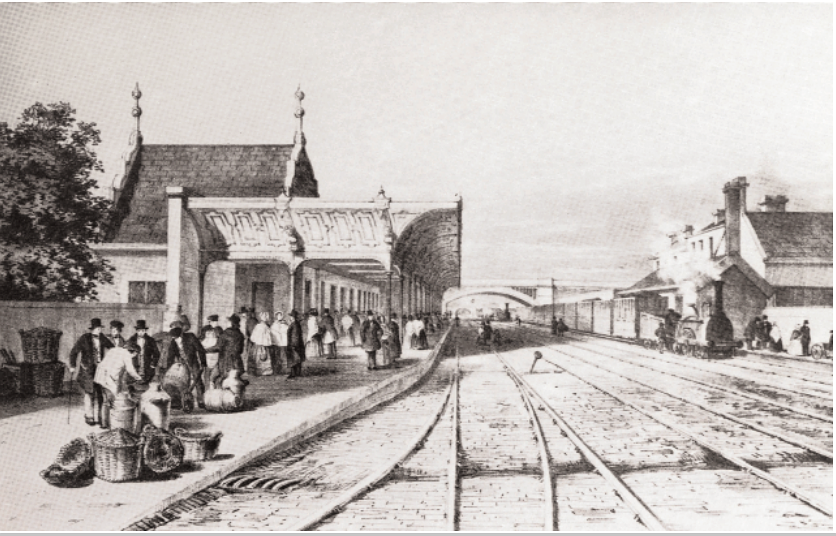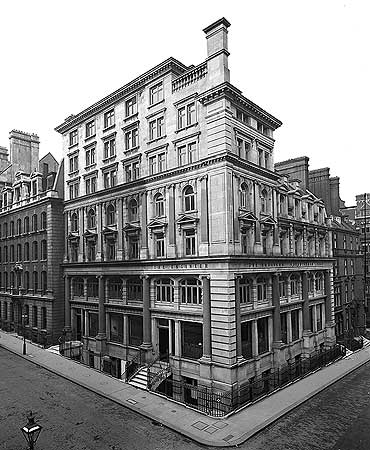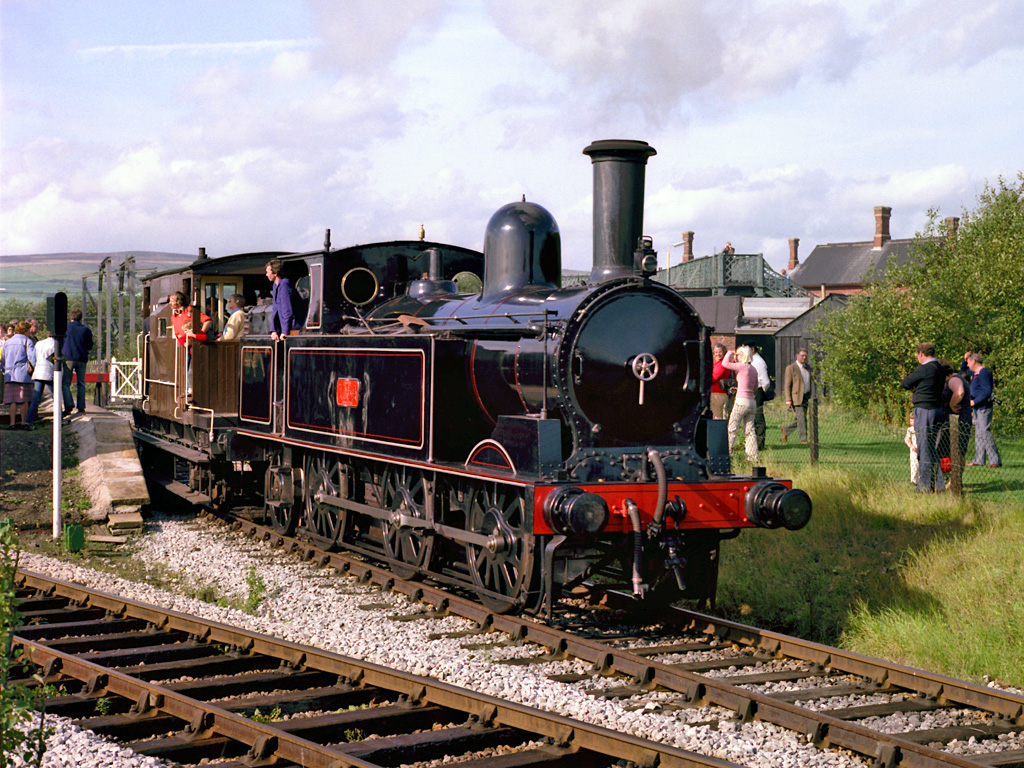|
Francis Webb (engineer)
Francis William Webb (21 May 1836 – 4 June 1906) was an English railway engineer, responsible for the design and manufacture of locomotives for the London and North Western Railway (LNWR). Webb was born in Tixall Rectory, near Stafford, the second son of William Webb, Rector of Tixall. Career Crewe Works Showing early interest in mechanical engineering, on 11 August 1851 at the age of fifteen he was articled as a pupil of Francis Trevithick at Crewe Works.Griffiths, p.51 Webb joined the drawing office in 1856, at the end of his training. He became Chief Draughtsman on 1 March 1859. On 1 September 1861 he was appointed Works Manager at Crewe and Chief Assistant to John Ramsbottom. Whilst Works Manager Webb was responsible for the installation of Bessemer converters and the start of steel production at Crewe. Bolton Iron and Steel Company In July 1866 Webb resigned from the LNWR and moved to the Bolton Iron and Steel Co. as the manager. It has been suggested that ... [...More Info...] [...Related Items...] OR: [Wikipedia] [Google] [Baidu] |
Tixall
Tixall is a small village and civil parish in the Stafford district, in the English county of Staffordshire lying on the western side of the Trent valley between Rugeley and Stone, Staffordshire and roughly 4 miles east of Stafford. The population of the civil parish taken at the 2011 census was 239. The place-name 'Tixall' is first attested in the Domesday Book of 1086, where it appears as ''Ticheshale''. Deriving from Old English, the name means 'the hollow of the goats'. It is a fairly elongated village lying to the west of Great Haywood and just north of the sprawling Shugborough estate, the River Sow forming the natural boundary between the two, which joins the Trent on the Shugborough estate a mile or so east of Tixall. The village has benefited substantially from its close proximity to such affluent estates as Shugborough to the south and Sandon Hall and Ingestre Hall to the north, homes of the Earl of Lichfield, the Earl of Harrowby and the Earl of Shrewsbury res ... [...More Info...] [...Related Items...] OR: [Wikipedia] [Google] [Baidu] |
LNWR Improved Precedent Class
The London and North Western Railway (LNWR) Improved Precedent Class or Renewed Precedent Class is a class of steam locomotives originally designed for express passenger work. They later gained the nickname of ''Jumbos''. History The locomotives were designed by F. W. Webb. A total of 158 were built in batches by Crewe Works 1887–1897 with two further additions in 1898 and 1901 respectively. They were officially "renewals" (i.e. replacements) of 96 Newton Class and 62 Precedent Class, so that, for accountancy purposes, they could be charged against the Revenue account rather than the Capital account of a "new" locomotive. On renewal, they kept the numbers and names of their predecessors, and as a result the numbering system continued to be completely haphazard. In addition, the eight Precedent class locomotives that were not renewed, were rebuilt to the Improved specification, but they retained their original thick frames, whereas the renewed locomotives had frames. On ... [...More Info...] [...Related Items...] OR: [Wikipedia] [Google] [Baidu] |
Institution Of Civil Engineers
The Institution of Civil Engineers (ICE) is an independent professional association for civil engineers and a charitable body in the United Kingdom. Based in London, ICE has over 92,000 members, of whom three-quarters are located in the UK, while the rest are located in more than 150 other countries. The ICE aims to support the civil engineering profession by offering professional qualification, promoting education, maintaining professional ethics, and liaising with industry, academia and government. Under its commercial arm, it delivers training, recruitment, publishing and contract services. As a professional body, ICE aims to support and promote professional learning (both to students and existing practitioners), managing professional ethics and safeguarding the status of engineers, and representing the interests of the profession in dealings with government, etc. It sets standards for membership of the body; works with industry and academia to progress engineering standards a ... [...More Info...] [...Related Items...] OR: [Wikipedia] [Google] [Baidu] |
Crewe Station
Crewe railway station is a railway station in Crewe, Cheshire, England. It opened in 1837 and is one of the most historically significant railway stations in the world.Guardian newspaper article, ''The beauty of Crewe'' (6 December 2005). Retrieval Date: 10 August 2007. Crewe station is a major junction on the and serves as a rail gateway for . It is 158 miles north of |
The Engineer (UK Magazine)
''The Engineer'' is a London-based monthly magazine and website covering the latest developments and business news in engineering and technology in the UK and internationally. History and description ''The Engineer'' was founded in January 1856. It was established by Edward Charles Healey, an entrepreneur and engineering enthusiast with financial interests in the railways whose friends included Robert Stephenson and Isambard Kingdom Brunel. The journal was created as a technical magazine for engineers. ''The Engineer'' began covering engineering including inventions and patents during a high point of British economic manufacturing power. In the 19th century it also published stock prices of raw materials. Together with the contemporary ''Engineering'' journal the work is considered a valuable historical resource for the study of British economic history. On 10 July 2012 the magazine announced its final print edition, the editor Jon Excell citing "increasing distribution and ... [...More Info...] [...Related Items...] OR: [Wikipedia] [Google] [Baidu] |
LNWR Webb Experiment Class
The London and North Western Railway ''Experiment'' Class was a series of 30 three-cylinder 2-(2-2)-0 compound locomotives designed by Francis Webb for the London and North Western Railway between 1882 and 1884. They were Webb’s first large-scale experiment with a class of express compound locomotives, and the first engine was named accordingly. They were followed by a class of similar, but larger locomotives, that featured larger boilers and smaller driving wheels – the LNWR Dreadnought Class. After Webb's retirement, his successor, George Whale, withdrew the ''Experiment'' class locomotives soon after he took up office in 1903. Accidents and incidents : *On 22 December 1894, a gust of wind blew a wagon into a rake of wagons at , Cheshire. They were derailed and fouled the main line. Locomotive No. 520 ''Express'' was one of two hauling an express passenger train that collided with the wagons and was derailed. 14 people were killed and 48 were injured. Locomotives Ref ... [...More Info...] [...Related Items...] OR: [Wikipedia] [Google] [Baidu] |
Compound Locomotive
A compound locomotive is a steam locomotive which is powered by a compound engine, a type of steam engine where steam is expanded in two or more stages. The locomotive was only one application of compounding. Two and three stages were used in ships, for example. Compounding became popular for railway locomotives from the early 1880s and by the 1890s were becoming common. Large numbers were constructed, mostly two- and four-cylinder compounds, in France, Germany, Austria, Hungary, and the United States. It declined in popularity due to maintenance issues and because superheating provided similar efficiencies at lower cost. Nonetheless, compound Mallets were built by the Norfolk and Western Railway right up to 1952. Introduction In the usual arrangement for a compound engine the steam is first expanded in one or two high-pressure ''(HP)'' cylinders, then having given up some heat and lost some pressure, it exhausts into a larger-volume low-pressure ''(LP)'' cylinder, (or two, - or ... [...More Info...] [...Related Items...] OR: [Wikipedia] [Google] [Baidu] |
London, Midland And Scottish Railway
The London, Midland and Scottish Railway (LMSIt has been argued that the initials LMSR should be used to be consistent with LNER, GWR and SR. The London, Midland and Scottish Railway's corporate image used LMS, and this is what is generally used in historical circles. The LMS occasionally also used the initials LM&SR. For consistency, this article uses the initials LMS.) was a British railway company. It was formed on 1 January 1923 under the Railways Act of 1921, which required the grouping of over 120 separate railways into four. The companies merged into the LMS included the London and North Western Railway, Midland Railway, the Lancashire and Yorkshire Railway (which had previously merged with the London and North Western Railway on 1 January 1922), several Scottish railway companies (including the Caledonian Railway), and numerous other, smaller ventures. Besides being the world's largest transport organisation, the company was also the largest commercial enterprise ... [...More Info...] [...Related Items...] OR: [Wikipedia] [Google] [Baidu] |
0-8-0
Under the Whyte notation for the classification of steam locomotives, represents the wheel arrangement of no leading wheels, eight powered and coupled driving wheels on four axles and no trailing wheels. Locomotives of this type are also referred to as eight coupled. Overview Examples of the 0-8-0 wheel arrangement were constructed both as tender and tank locomotives. The earliest locomotives were built for mainline haulage, particularly for freight, but the configuration was later also often used for large switcher (shunter) types. The wheel arrangement provided a powerful layout with all engine weight as adhesive weight, which maximised the tractive effort and factor of adhesion. The layout was generally too large for smaller and lighter railways, where the more popular wheel arrangement would often be found performing similar duties. Usage Austria Two 0-8-0 locomotives were delivered from Andre Koechlin & Cie in Mulhouse to the Austrian Southern Railway in 1862. They were ... [...More Info...] [...Related Items...] OR: [Wikipedia] [Google] [Baidu] |
LNWR 18in Goods Class
The LNWR 18-inch Goods was a class of 310 0-6-0 freight steam locomotives built by the London and North Western Railway at their Crewe Works between 1880 and 1902. They were also known officially as the Express Goods 5 ft 0in, and unofficially as the Crested Goods or Cauliflower Class, due to the application of the large LNWR crest on the middle splasher in the original livery. Design The design featured a boiler pressed to delivering saturated steam to two cylinders connected by Joy valve gear to the driving wheels. The dimensions quoted in the class title could be misleading: several locomotives ran for a period with cylinders; and the “5ft 0in” referred to the diameter of the wheel centres – measured of the tyres the diameter was . A tank locomotive version was also produced as the LNWR 18in Tank Class 0-6-2T. Service Two locomotives were withdrawn before the 1923 Grouping, leaving 308 to pass to the London, Midland and Scottish Railway, who gave them powe ... [...More Info...] [...Related Items...] OR: [Wikipedia] [Google] [Baidu] |
LNWR Webb Coal Tank
The London and North Western Railway (LNWR) Webb Coal Tank is a class of 0-6-2T steam locomotive. They were called "Coal Tanks" because they were a side tank version of Webb's standard LNWR 17in Coal Engine, an 0-6-0 tender engine for slow freight trains. Design The design was introduced in 1881 by F.W. Webb and had the same cheaply produced cast iron wheels and H-section spokes as the tender engines. A trailing radial axle supporting the bunker was added also with two similarly cast iron wheels. Three hundred were built between 1881 and 1897. Operational history Four (LNWR nos. 178, 484, 1257, 69) were withdrawn in January–February 1920 and a further four (LNWR nos. 142, 994, 782, 1012) in July and November 1922, so at the 1923 grouping, 292 passed to the London Midland and Scottish Railway (LMS). They were renumbered from the LNWR's random allocation based on vacant numbers, to a solid block sequence 7550–7841, and given the power classification 1F. Many locomotives st ... [...More Info...] [...Related Items...] OR: [Wikipedia] [Google] [Baidu] |
0-6-2
Under the Whyte notation for the classification of steam locomotives, represents the wheel arrangement of no leading wheels, six powered and coupled driving wheels on three axles and two trailing wheels on one axle. The type is sometimes known as a Webb or a Branchliner. Overview While some locomotives with this wheel arrangement had tenders, the majority were tank locomotives which carried their coal and water onboard. Usage Finland Finland used two classes of 0-6-2T locomotive, the Vr2 and the Vr5. The Vr2 class was numbered in the range from 950 to 965. Five of them are preserved in Finland, no. 950 at Joensuu, no. 951 at Tuuri, no. 953 at Haapamäki, no. 961 at Jyväskylä and no. 964 at the Veturimuseo at Toijala. The Vr5 class was numbered in the range from 1400 to 1423. No. 1422 is preserved at Haapamäki. Philippines There were 30 ''Dagupan''-type locomotives built between 1889 and 1890. All were tank locomotives, weighed and were run a maximum speed of . These ... [...More Info...] [...Related Items...] OR: [Wikipedia] [Google] [Baidu] |








.jpg)